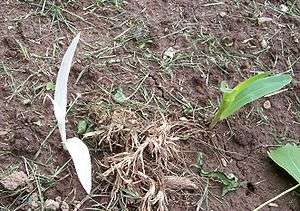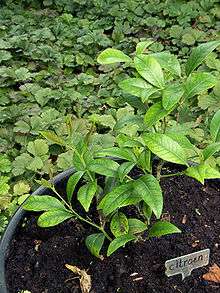Chlorosis

In botany, chlorosis is a condition in which leaves produce insufficient chlorophyll. As chlorophyll is responsible for the green color of leaves, chlorotic leaves are pale, yellow, or yellow-white. The affected plant has little or no ability to manufacture carbohydrates through photosynthesis and may die unless the cause of its chlorophyll insufficiency is treated, although some chlorotic plants, such as the albino Arabidopsis thaliana mutant ppi2, are viable if supplied with exogenous sucrose.[1]
Chlorosis is derived from the Greek khloros meaning 'greenish-yellow', 'pale green', 'pale', 'pallid', or 'fresh'.
In viticulture, the most common symptom of poor nutrition in grapevines is the yellowing of grape leaves caused by chlorosis and the subsequent loss of chlorophyll. This is often seen in vineyard soils that are high in limestone such as the Italian wine region of Barolo in the Piedmont, the Spanish wine region of Rioja and the French wine regions of Champagne and Burgundy. In these soils the grapevine often struggles to pull sufficient levels of iron which is a needed component in the production of chlorophyll.[2]
Causes


Chlorosis is typically caused when leaves do not have enough nutrients to synthesise all the chlorophyll they need. It can be brought about by a combination of factors including:
- a specific mineral deficiency in the soil, such as iron,[3] magnesium or zinc [4]
- deficient nitrogen and/or proteins[4]
- a soil pH at which minerals become unavailable for absorption by the roots [5]
- poor drainage (waterlogged roots) [5]
- damaged and/or compacted roots [5]
- pesticides and particularly herbicides may cause chlorosis, both to target weeds and occasionally to the crop being treated.[6]
- exposure to sulphur dioxide[7]
- ozone injury to sensitive plants
- presence of any number of bacterial pathogens, for instance Pseudomonas syringae pv. tagetis that causes complete chlorosis on Asteraceae.[8]
However, the exact conditions vary from plant type to plant type. For example, Azaleas grow best in acidic soil and rice is unharmed by waterlogged soil.
Chlorosis in grape vines
Like many other plants, grape vines are susceptible to chlorosis, and symptoms of iron deficiency tend to be common on soils rich in limestone. In the wake of The Great French Wine Blight, when European Vitis vinifera were affected by Phylloxera, chlorosis became a greater problem in viticulture. To deal with the Phylloxera blight, V. vinifera was grafted onto rootstock based on American species of the Vitis genus, such as Vitis riparia, Vitis rupestris, Vitis berlandieri. However, many of these were less adapted to the lime-rich soils that were common in France's vineyards, in particular many of those that produced wines of top quality. Many grafted vines in lime-rich vineyards therefore showed signs of iron deficiency, and in France this specific form of chlorosis was termed chlorose calcaire. The problem was largely overcome by the selection of lime-resistant American vines as basis for hybrid vines used for rootstock material. However, since such rootstocks may be less than optimal in other respects, it is necessary for the viticulturalist to balance the need for chlorosis resistance against other viticultural needs. This is illustrated by one of the most common lime-resistant rootstocks, 41 B, which is a hybrid between V. vinifera cultivar Chasselas and V. berlandieri, which generally has a sufficient, but not extremely high, Phylloxera resistance.[9][10]
Treatments
Specific nutrient deficiencies (often aggravated by high soil pH) may be corrected by supplemental feedings of iron, in the form of a chelate or sulphate, magnesium or nitrogen compounds in various combinations.
See also
| Wikimedia Commons has media related to Chlorosis. |
References
- ↑ Kubis S, Patel R, Combe J, et al. (August 2004). "Functional specialization amongst the Arabidopsis Toc159 family of chloroplast protein import receptors". Plant Cell. 16 (8): 2059–77. doi:10.1105/tpc.104.023309. PMC 519198
 . PMID 15273297.
. PMID 15273297. - ↑ Wine & Spirits Education Trust "Wine and Spirits: Understanding Wine Quality" pg 16, Second Revised Edition (2012), London, ISBN 9781905819157
- ↑ Koenig, Rich and Kuhns, Mike: Control of Iron Chlorosis in Ornamental and Crop Plants. (Utah State University, Salt Lake City, August 1996) p.3
- 1 2 Botany for Gardeners, p. 178, 3rd edition, Brian Capon, Timber Press 2010
- 1 2 3 Schuster, James. "Focus on Plant Problems - Chlorosis". University of Illinois. Retrieved 2008-12-22.
- ↑ Pests of Landscaped Trees and Shrubs: An Integrated Pest Management Guide By Steve H. Dreistadt, Jack Kelly Clark, p. 284, Regents of the University of California Division of Agriculture and Natural Resources, 2004
- ↑ Trees for Problem Landscape Sites -- Air Pollution, Virginia Tech May 2009
- ↑ https://www.unifr.ch/webnews/content/20/File/artikel_weedresearch(1).pdf
- ↑ Jancis Robinson, ed. (2006). "Chlorosis". Oxford Companion to Wine (3rd ed.). Oxford: Oxford University Press. p. 170. ISBN 0-19-860990-6.
- ↑ Jancis Robinson, ed. (2006). "Rootstock". Oxford Companion to Wine (3rd ed.). Oxford: Oxford University Press. pp. 591–3. ISBN 0-19-860990-6.